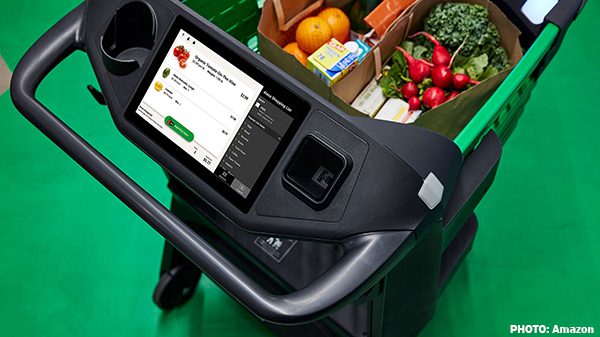Smart carts are expensive, costing more than $5,000 each, according to media reports.
Smart cart developer Caper AI claims the breakeven point is 10 months for its AI Cart Model 2. The company also says the cart’s ability to make purchase recommendations has helped increase the average basket size by 18 percent.
Some companies have developed devices that can turn any shopping cart into a smart cart. These devices include the same AI technology as smart carts.
The technology, however, is not without issues.
Amazon’s Dash Cart, in use at almost two dozen Amazon Fresh stores, only holds two bags of groceries and a maximum of 40 pounds, making it appropriate only for small- to medium-sized shopping trips.
Additionally, shoppers cannot take the carts outside the store.
And as David Bishop, partner at Brick Meets Click in Barrington, IL, found out, the carts can be prone to error.
“I put six wine bottles in the cart—it only counted four, but I didn’t get an error message,” Bishop says. “In my mind, cart technology is in beta.”
An Inmar Intelligence survey released in April 2021 reported 75 percent of shoppers are willing to use technology that allows them to check out from their cart. And yet, Dash Cart usage doesn’t appear to have much consumer engagement.
In February, Business Insider reported usage has steadily declined and “accounted for only 11 percent to 15 percent of total shopping sessions at stores that have been open for longer than five weeks as of last August.”
“Either the customer didn’t understand all the things it can do, or didn’t necessarily care about the benefits,” Bishop says.
An Amazon Fresh employee told him that the company plans to go forward with Just Walk Out technology, although Amazon’s website continues to tout Dash Cart.
This is an excerpt from the Applied Technology feature in the July/August 2022 issue of Produce Blueprints Magazine. Click here to read the whole issue.



